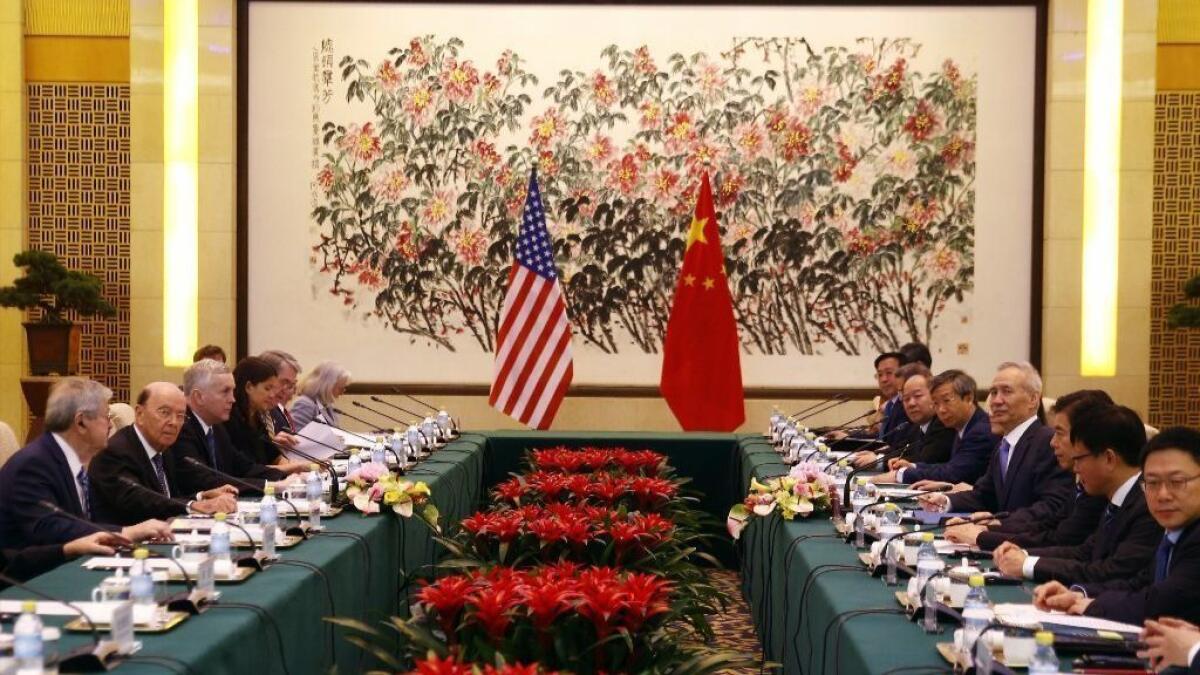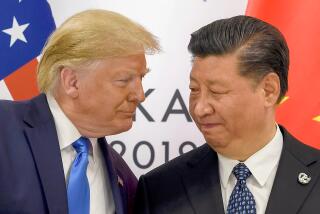In prelude to trade war, U.S. details tariffs on $50 billion of Chinese goods

Reporting from Washington — President Trump announced Friday that the U.S. would go ahead with hefty tariffs on about $50 billion worth of Chinese goods, following through on a threat that could ignite a global trade war.
“These tariffs are essential to preventing further unfair transfers of American technology and intellectual property to China, which will protect American jobs,” Trump said in a written statement. “In addition, they will serve as an initial step toward bringing balance to the trade relationship between the United States and China.”
Trump again complained about the large U.S. trade deficit with China. The administration has portrayed the tariffs as a targeted strike at technology theft and a broader pressure tactic in trade negotiations with Beijing.
The tariff announcement sent the Dow Jones industrial average tumbling about 280 points in early trading Friday. It recovered to close down 84.83 points, or 0.3%, at 25,090.48.
Beijing vowed to retaliate dollar-for-dollar and already has singled out big-ticket U.S. imported products, such as soybeans and aircraft, to maximize political pressure.
“China doesn’t want a trade war,” said a spokesman for China’s Foreign Ministry in Beijing. But “confronted by such short-sighted” action, China “will immediately take tariff measures of the same scale and intensity,” he said.
Trump’s statement said the U.S. “will pursue additional tariffs if China engages in retaliatory measures.”
Despite those threats of escalating actions, Trump dismissed warnings that his move Friday to impose the additional 25% duties on hundreds of Chinese imports would start a global trade war even as some top Republicans and business groups criticized the step.
“The trade war was started many years ago by them, and the United States lost,” he said on Fox News’ “Fox & Friends” shortly after the tariffs were announced.
Some analysts saw the latest announcement as more saber-rattling by the administration to pressure China to make concessions.
But so far the imposition or threat of tariffs has mostly inflamed trading partners and allies alike, eliciting promises of retaliatory countermeasures and legal filings challenging the administration’s actions at the World Trade Organization.
Most analysts, businesses and lawmakers agree that China has not played fair in trade. But Trump’s impulsive trade rhetoric and unilateral policy moves have isolated the U.S. and opened up America to criticisms of undermining the global trading order.
“China is not surprised by Trump’s tactics, considering Trump could prey on his closest allies like Canada and the E.U., why not China,” said Alex He, research fellow at the Centre for International Governance Innovation, a Canadian think tank, and former associate professor at the Chinese Academy of Social Sciences.
“China’s tired of Trump’s game of deal-or-no-deal when it comes to trade and will respond to the tariffs calmly,” he said.
About two-thirds of the new U.S. duties on 1,102 types of imported goods will take effect July 6. The rest were newly proposed Friday and will kick in later after a review period.
The list issued Friday targets categories of Chinese products that administration officials consider to be “industrially significant technology,” and is meant to punish China for alleged theft of intellectual property as well as policies that force U.S. firms to hand over technology secrets.
The levies are aimed at China’s development of strategic sectors including aerospace, robotics and communications.
“We have the great brain power in Silicon Valley, and China and others steal those secrets and we’re going to protect those secrets,” Trump said on “Fox & Friends.” “Those are crown jewels for this country.”
The U.S. trade representative’s office said the list does not include consumer products such as cellphones and televisions, many of which are made or assembled in China.
But lawmakers from both parties and some major business groups warned average Americans could suffer the collateral damage through higher prices. Tariffs are paid by U.S. importers, who then decide whether to pass on the cost to customers.
“Imposing tariffs places the cost of China’s unfair trade practices squarely on the shoulders of American consumers, manufacturers, farmers, and ranchers,” said Thomas J. Donohue, president of the U.S. Chamber of Commerce. “This is not the right approach.”
A new poll shows the American public might agree.
Respondents to the Monmouth University poll released Friday were split evenly, with 36% saying tariffs are generally good and 36% saying they were generally bad. But 40% said the decision to impose tariffs on U.S. trading partners — not just China but Canada, Mexico, Japan and Europe — would hurt the U.S. economy, while 25% said they would help.
Some top Republicans urged caution.
Senate Finance Committee Chairman Orrin Hatch (R-Utah) said Trump’s effort to combat the theft of U.S. intellectual property was “laudable.” But he warned of the harm tariffs would cause to U.S. and Chinese businesses.
“Ill-conceived trade actions that weaken the American economy, alienate allies, and invite retaliation against American businesses, farmers and ranchers undermine our nation’s ability to successfully confront China’s unfair trade policies,” Hatch said.
He urged Beijing to “act expeditiously to change its policies to avoid the damaging effects of tariffs and escalating retaliation.”
Rep. Kevin Brady (R-Texas), chairman of the House Ways and Means Committee, said he was encouraged that the Trump administration had removed some of the products originally proposed to face tariffs when imported from China. But he said he was “alarmed” that some new product categories were added and he urged the administration to narrow the list.
“These tariffs make it more difficult to sell more ‘Made in America’ products globally and expose many of our industries – particularly agriculture and chemicals – to devastating retaliation,” Brady said.
A bipartisan effort in Congress to limit Trump’s tariff authority has stalled because of opposition from Republican leaders.
U.S. Trade Representative Robert Lighthizer used unusually tough language in a statement announcing the list of new taxes on imports from China:
“We must take strong defensive actions to protect America’s leadership in technology and innovation against the unprecedented threat posed by China’s theft of our intellectual property, the forced transfer of American technology, and its cyber attacks on our computer networks.”
“China’s government is aggressively working to undermine America’s high-tech industries and our economic leadership through unfair trade practices and industrial policies like ‘Made in China 2025,’” he said, referring to Chinese President Xi Jinping’s signature economic plan to build up domestic companies in core industries.
The original list of 1,333 Chinese goods slated for tariffs, including TVs, chemicals and pharmaceuticals, was pared to 818 after three public hearings. Those 818 goods amount to about $34 billion in imports from China.
But as part of the review process, the administration added 284 new product lines, amounting to about $16 billion in imports from China, to the tariff list. Those will undergo a similar review, including public comment, before taking effect.
The products slated for new U.S. tariffs are covered by the “Made in China 2025” plan or produced by industries that have benefited from technology or intellectual property that U.S. companies were required to transfer to China in order to do business there, said Erin Ennis, senior vice president at the U.S.-China Business Council, which represents American companies doing business there.
Additionally, the administration has said that by June 30 it would make public measures to restrict China’s access to important U.S. technology, and that those also would take effect soon.
As Trump has stepped up actions on trade this year, slapping tariffs on washers, solar panels and steel, the U.S. and China have held high-level talks in a so-far unsuccessful effort to ease tensions.
Chinese officials have at various times offered to buy more U.S. goods to reduce America’s large trade deficit — a perennial complaint by Trump.
Last month, it appeared the Chinese offer might resolve, or at least put on hold, a looming trade war between the world’s two largest economies. But in the last couple of weeks, the influence of trade hard-liners in the White House has grown, and Trump has moved back toward confrontation with Beijing.
The White House has said the tariff list would focus on products that would affect China’s bid to move up the value ladder in manufacturing.
Secretary of State Mike Pompeo, who was in Beijing on Thursday after stops in Korea and Japan following Trump’s summit with North Korean leader Kim Jong Un, said his talks with the Chinese included trade, and he described the discussions as “good and constructive.”
At a joint news conference with China’s Foreign Minister Wang Yi, Pompeo said that “our deficit with China is still too high.”
He said he “stressed how important it is for President Trump to rectify that situation so that trade becomes more balanced, more reciprocal and more fair, with the opportunity to have American workers be treated fairly.”
Pompeo did not mention the pending tariffs in his public remarks, but said that “when countries disagree, we speak up. When we cooperate, we can make great progress.”
Wang said that the U.S. had a choice, to cooperate for mutual gain or to confront for mutual loss.
“China chooses the first,” Wang said, adding that he hoped the U.S. side would make the “same wise choice.” If not, he warned, China has made preparations to respond.
Follow me at @dleelatimes
UPDATES:
1:30 p.m.: This article was updated with the closing level of the Dow Jones industrial average and additional details.
11:20 a.m.: This article was updated with comments from a spokesman for China’s Foreign Ministry and Erin Ennis of the U.S.-China Business Council
9:30 a.m.: This article was updated with additional information on the tariffs, reaction from Rep. Kevin Brady and outside analysts and other details.
8:50 a.m.: This article was updated with additional details and comments from Rep. Kevin Brady; Thomas Donohue, president of the U.S. Chamber of Commerce; and Alex He, research fellow at the Centre for International Governance Innovation.
This article originally was published at 7:10 a.m.
More to Read
Inside the business of entertainment
The Wide Shot brings you news, analysis and insights on everything from streaming wars to production — and what it all means for the future.
You may occasionally receive promotional content from the Los Angeles Times.












